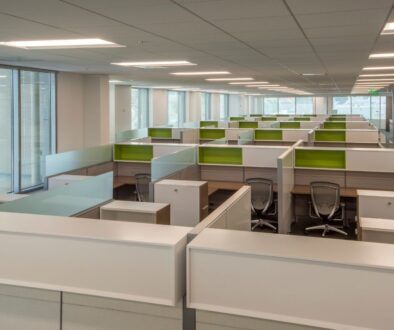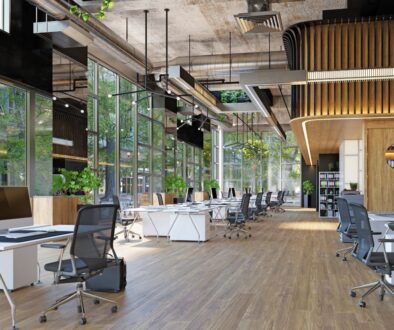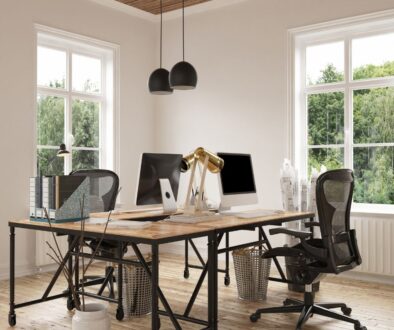How to Choose Cubicle Lighting for Small Offices
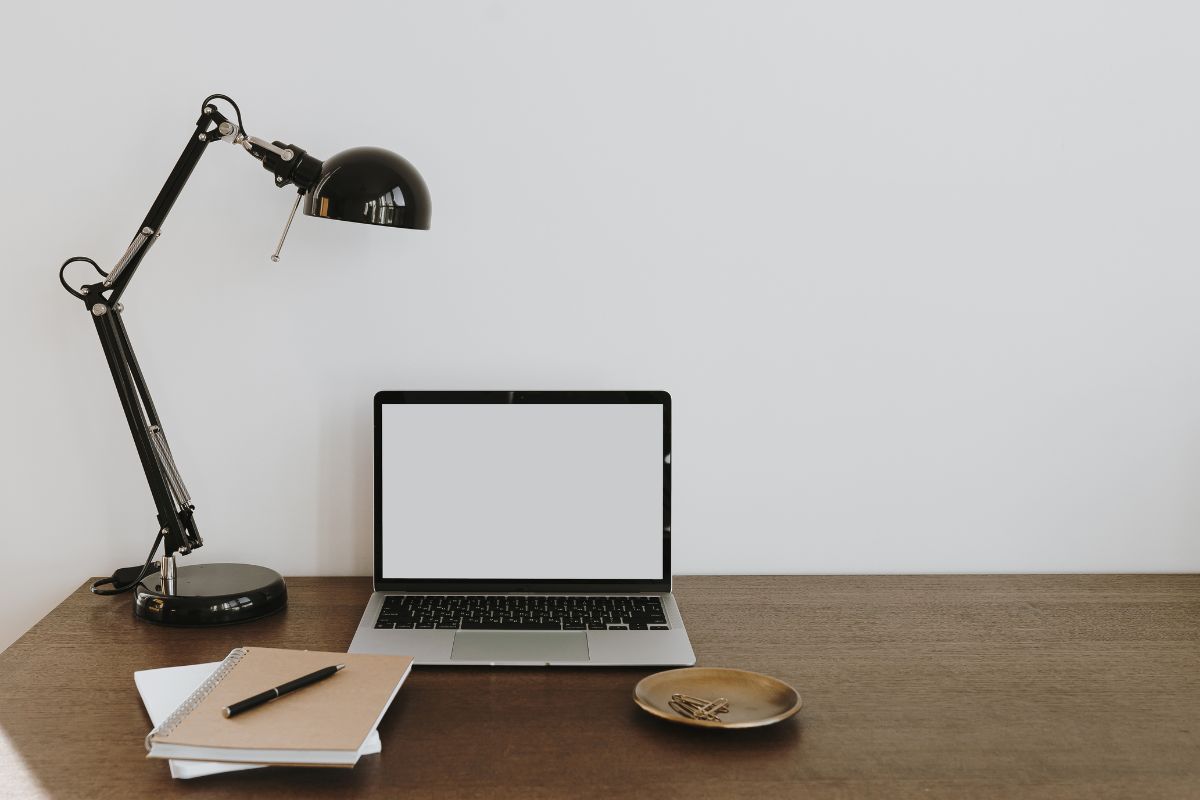
Published July 27, 2023
Poor cubicle lighting is frequently listed as one of the most prevalent interior design errors. While poor lighting is stressful and uncomfortable in any area, it may be challenging in a home office or any professional setting. In fact, poor lighting is one of the most often reported workplace concerns worldwide.
It’s simple to see why employees are dissatisfied with working in an environment that is either too bright or too dark. Improper office illumination can have a detrimental effect on worker productivity and the quality of work performed. Additionally, it might be a safety and health problem. Insufficient light can impair vision, making accidents and injuries considerably more likely to occur. Headaches, weariness, and eye strain, as well as wet or burning eyes, can also be caused by an excess or a deficiency of light. So how much illumination and what type of lighting should your cubicle or office building have? Consider the following recommendations when you make your choice.
What Are The Different Types of Lighting
To begin, do you know which type of cubicle lighting you should go for? There are different types available, and each has its own unique function and set of pros and cons. You can use a combination of these many lighting sources to create a well-lit working environment.
Natural Light
Any office building’s windows are valuable possessions. Unfortunately, they are rather uncommon and are usually reserved for CEOs with corner offices. Aside from providing a view, windows also give essential natural light.
Natural lighting is superior to any form of electric lighting, as numerous research studies, including one conducted in the United Kingdom and published in “The Responsible Workplace,” have demonstrated that exposure to natural light increases worker satisfaction with their workplace and productivity.
Also, natural light has a beneficial effect on our attitude and conduct in ways that artificial light cannot. Unfortunately, natural light is not always a practical alternative for your workstation. Utilize it whenever possible and arrange your office furniture accordingly.
Overhead Lighting
This is not the brightest sort of illumination and may cast shadows or simply be too dim. Generally, it is preferable to incorporate several sources of lighting than relying exclusively on an overhead light. For example, if you work in an office with fluorescent overhead lighting, adding either corrective or ambient lighting may alleviate some of the discomfort associated with fluorescent lights. When it comes to overhead lighting, you’ll want to choose lensed indirect lighting over direct parabolic lighting.
Task Lighting
If your office does not have enough natural and overhead light, you may want to consider installing task lighting on each employee’s wooden or metal desk. Task lights are small lamps – can be a desk lamp – that plug into any socket to give additional lighting precisely where an employee requires it. Additionally, there is a lot to choose from –– for example, LED lights, you can choose whether you want a cubicle LED task light or LED desk lamp –– that mimics the appearance of natural light.
Ambient Lighting
Wondering why you are so stressed out at work? It could be less about your workload and more about your environment. Ambient lighting is low-intensity and can assist you in creating a more serene atmosphere.
Corrective Lighting
Working on a computer for hours at a time, day after day can induce eye strain and even migraines. Therefore, corrective lighting installed behind your computer monitor might be really beneficial—Moreover, this type of lighting assists in reducing the glare generated by the screen.
How to Appropriately Light Your Small Office: Reflected Glare vs. Direct Glare
Keep an eye out for glare, which may be particularly taxing on the eyes. Glare is classified into two types: reflected glare and direct glare. Reflected glare is frequently caused by gleaming furniture and computer monitors. Direct glare, on the other hand, is created by light fixtures that are installed incorrectly or by direct sunlight.
To eliminate direct glare, try repositioning light fixtures so that their light is reflected away from you rather than toward you. By increasing the brightness of the area or adding more lighting around whatever is creating the glare can help alleviate either form of glare. For example, corrective lighting with a warm white light is ideal for reducing the glare created by computer monitors.
Take note of areas with insufficient light distribution. You’ll want an evenly lighted office or workstation. This is where the many types of lighting come into play, as each can contribute to a completely balanced filling of a room, resulting in much happier and satisfied employees.
Furthermore, you should absolutely consider how the color of your office or workspace’s walls influences the lighting. Since ultra-bright or glossy wall paints might induce glare, you may wish to avoid them.
How to Know If Your Cubicle Lighting Needs to be Changed
One of the most effective ways to determine whether your office or cubicle is truly suffering from poor lighting is to ask yourself or the other employee if they experience any of the extremely common and severe side effects. Are you prone to eye strain? Do you find yourself squinting from color temperatures during the day? Are you frequently afflicted with headaches while sitting at your desk or staring at your computer screen?
Another, more scientific way of determining where your office lacks sufficient illumination is to do several ergonomic tests. It is possible to decide on the average level of lighting in your workspace. Carry out this task and compare your findings to the recommendations for maximum productivity and safety.
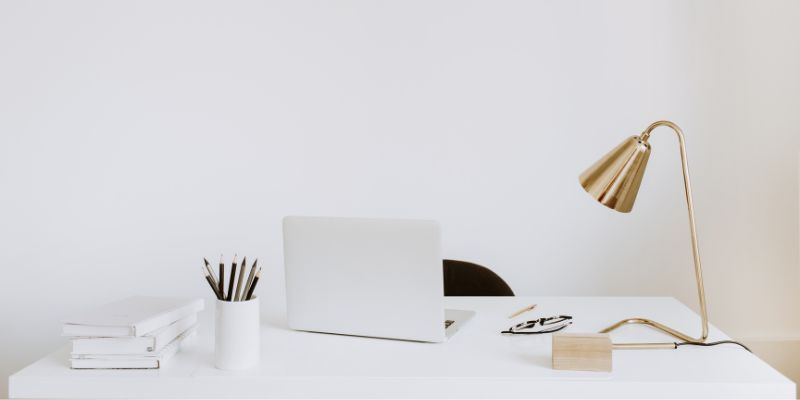
Best Light for Cubicles
For small offices, space availability is an important consideration when choosing cubicle lighting. This makes a desk lamp and mounted light practical options, making them like an add-on cubicle accessory.
Desk Lamps
Desk lamps minimize glares and shadows, making reading easier to the eyes. It also counters the often harsh effects of ambient office lighting. Depending on your type of work and desk space, there is a table lamp suitable for your needs.
RECOMMENDED DESK LAMP BRANDS FOR SMALL OFFICES:
These lamps feature multiple brightness levels, color temperature options, and adjustable angles to suit your needs. They also come with USB charging ports for added convenience. You can find these on their official website and on platforms like Amazon, Walmart, eBay, and Best Buy.
A versatile lighting solution that can be attached to various surfaces, such as desks, shelves, or headboards. It features a flexible gooseneck design, allowing you to adjust the light direction. This clip-on light provides bright and focused illumination for tasks or reading. You can find this Desk Light on Amazon and other online retailers.
A sleek and compact option for desk lighting that features a built-in USB port for charging devices and has a touch-sensitive base for easy control. This desk lamp offers multiple brightness levels and a modern design that fits well in various settings. You can find it on Amazon and other online platforms.
The Lavish Natural Sunlight Desk Lamp aims to simulate natural sunlight. It provides a bright and energizing light source for your desk. It helps reduce eye strain and fatigue by offering a more natural lighting experience than traditional desk lamps. This desk lamp is adjustable and comes with different brightness settings. It is available on Amazon and other online retailers.
The DEEPLITE Adjustable LED Desk Lamp features a flexible gooseneck design that allows you to adjust the light angle and direction. It offers multiple brightness levels and color temperatures to suit different tasks and preferences. This desk lamp also has a built-in USB charging port for added convenience. The Desk Lamp can be found on Amazon and other online platforms.
Mounted Lights
If your table is too busy for a desk lamp, you can mount task lights somewhere near your office chairs. They provide the same quality of light without taking up too much space. They’re also energy-saving as only specific areas are illuminated.
RECOMMENDED MOUNTED LIGHTS FOR SMALL OFFICES:
EShine offers dimmable LED cabinet lighting kits with hand wave activation and touchless dimming control. These lights are designed for various spaces such as kitchens, pantries, garages, workshops, and desks. These lights are found on the EShine Store website, Amazon, Home Depot, Walmart, and other online retailers.
The Brilliant Evolution Wireless Ultra-thin LED Lightbar is a versatile under-cabinet lighting solution. It features a slim design and can be easily installed without any wiring. These wireless lightbars provide bright and efficient LED lighting for various applications. You can find them on Amazon and other online retailers.
These portable wireless LED lights are designed to be stuck anywhere. This makes them a convenient option for under-cabinet lighting. They offer easy installation and can be used in various locations, not limited to just cabinets. These lights are battery-powered and provide enough brightness. You can find them on Amazon and other online retailers.
ASOKO offers dimmable LED under-counter lighting options. These lights are designed to be installed under counters or cabinets. They provide adjustable brightness levels. They are energy-efficient and can enhance the visibility of your workspace. You can find it on Amazon and other online platforms.
Under Shelf Lighting
Under Shelf Lighting for office cubicles is a lighting system installed underneath the shelves or cabinets. It provides additional illumination to the workspace. This makes it easier for employees to see and perform their tasks effectively. These lights are designed to give users greater control over their workspace. They feature standard shelf lights angled for optimum lighting coverage.
RECOMMENDED UNDER SHELF LIGHTS FOR OFFICE CUBICLES:
National Business Furniture provides a set of two 36-inch LED under-cabinet lights, ideal for mounting on hutches or floating cabinets in offices and cubicles. These lights offer efficient task lighting for workspaces. Buy it on National Busine Furniture’s website.
Steelcase offers performance-enhancing, energy-smart shelf lighting for office cubicles. These lights give users greater control over their workspace. They feature standard shelf lights angled for optimum lighting coverage. You can buy these at Steelcase’s website.
The BLACK+DECKER Verve Designer Clamp Light is a versatile lighting solution that can fit on shelves, cubicles, and headboards. It features a true white LED light and color ambiance options. This allows users to adjust the lighting according to their preferences. You can buy this on Amazon.
OmniMax Parts offers under-cabinet cubicle lighting in different size options. These task lights can be selected to fit office furniture. They provide additional lighting for workspaces in office cubicles. You can buy it on OmniMax Parts’ website.
Searching For The Perfect Office In Boca Raton, Florida?
Find executive office space for rent in Boca Raton at our four story building on Federal Highway. Our convenient location is close to many great restaurants and the I-95 highway. Our flexible lease agreement and amenities are great for small businesses and startups. Enjoy unlimited free brewed coffee, cappuccino, and espresso daily from our kitchen. High speed internet and cleaning service are complimentary. Don’t wait, contact us now to schedule a tour.
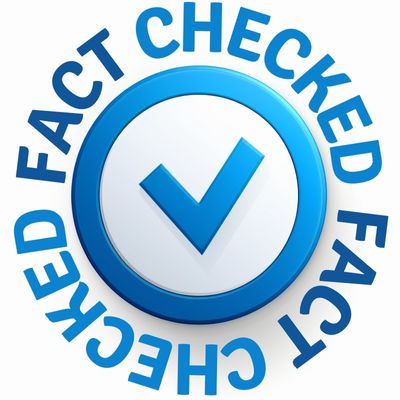
This Content Is Fact Checked
This content has undergone a comprehensive fact-checking process led by our internal team. Discover more about the rigorous standards that govern our website’s editorial integrity here.

About The Author
Meet Rei Bayucca, an experienced writer with a wealth of knowledge across a range of industries. Her passion for crafting thought-provoking articles inspires and educates readers. Get ready to be informed and inspired by her well-crafted content.
